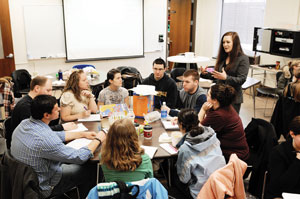|
SUNY Fredonia’s pledge to provide small classes to its more than 5,300 undergraduate students has earned the university the 15th spot in a nationwide survey of affordable, well-regarded colleges and universities, as compiled by U.S. News & World Report.
The rankings, announced in the article, “Colleges That Offer Small Classes on a Budget,” published in the magazine’s Dec. 10, 2009 edition, placed SUNY Fredonia among 30 colleges across the country whose in-state tuition and fees were under $10,000 in 2008. In that year, Fredonia enrolled 5,178 students and had in-state tuition and fees of $6,258.
“I was glad to see Fredonia being recognized for something that is clearly a hallmark of educational quality: a commitment to keeping class size small, despite the economic challenges we face,” said Vice President for Academic Affairs Virginia Horvath. The numbers announced in the survey demonstrate that Fredonia students are learning primarily in small classes, she explained, due to the university’s commitment to that proven learning environment.
According to the article, more than half — 54 percent — of all classes at SUNY Fredonia contained 19 or fewer students, the definition the magazine set for “small class size.”
A common worry among students is that their educational experience will be comprised by cavernous lecture rooms and lack of individual attention from professors that typically occur in large class sizes, according to the article’s author, Kim Clark. Studies confirm that learning is enhanced in smaller, more intimate classrooms.
“Attending a big, affordable public university doesn’t doom a student to large lecture halls,” Clark wrote.
Classes are often small, even individual, in the fine and performing arts at SUNY Fredonia, but small classes are found throughout the curriculum, Dr. Horvath said. While higher level courses are more likely to be seminar style, many first-year courses — such as English composition and mathematics classes — are deliberately kept small.
Class size is a major concern of high school seniors, affirmed Admissions Director Chris Dearth. “Many students that choose mid-size institutions such as Fredonia do not want to get lost in large classes. They are looking for an experience where they can know their professors and classmates. The average class size and student-to-faculty ratio are questions that are asked every time a prospective student and his or her parents visit campus,” he said.
Continuing to offer small classes in such great numbers is indeed an accomplishment, particularly at a time when colleges and universities across the country are seeking ways to control costs, often resorting to packing more students into classrooms, laying off faculty, or both, while at the same time at least maintaining or increasing enrollment to generate new revenue.
SUNY Fredonia’s commitment to offer small class sizes will not change in the future, university officials said. In fact, initial plans for the $60 million Science and Technology Center include a single lecture hall, while most of the space in the new facility will consist of flexibly designed learning spaces for no more than 25 students at a time, with plenty of informal social studying areas.
“We at Fredonia pride ourselves on the close faculty-student collaborations that are possible when people have a chance to know one another and work together on research,” Dr. Horvath said.
SUNY Fredonia’s small-class ranking follows its placement last fall by U.S. News as the 14th best public, master’s granting university in the Northern U.S., according to the magazine’s 2010 edition of “America’s Best Colleges.”
“It’s no surprise that Fredonia shows up regularly in these prestigious rankings. Fredonia is a highly respected institution and offers students a tremendous value for the level of instruction they receive,” Dearth said.





